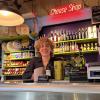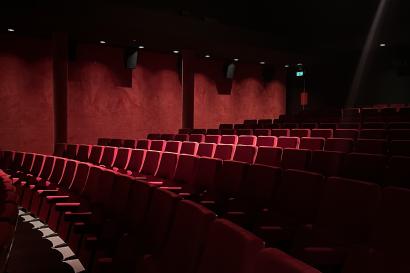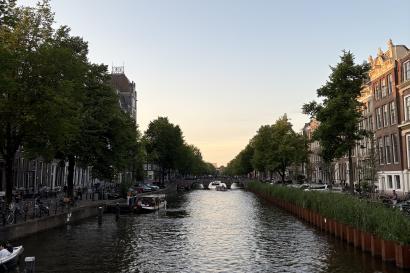The first two weeks of IES Abroad Amsterdam are essentially a vacation. You meet a bunch of awesome new people, explore the city, socialize in and out of IES Abroad orientations, and it’s still summer! However, despite the seemingly non-stop fun, setting up your Dutch phone, withdrawing cash without paying absurd ATM fees, and opening a Dutch bank account are the logistical nightmares that ground you before the semester starts and make you realize that it’s not just study abroad, but study (and live, independently) abroad. As I awake from this nightmare that’s been brooding beneath the surface of my study abroad excitement, I’ve reflected and compiled a list of helpful tips to make your transition into Dutch life as painless and economical as possible.
- SIM Card
IES Abroad requires all students to have a working phone during their time abroad. While some students opt to keep their U.S. phone number, usually because they have a robust international plan with calling and text, this is usually quite expensive, and also limits you from potentially setting up your Dutch bank account or other services.
IES Abroad requires you to have a working phone within the first five days, so purchasing a SIM card is a top priority. However, prepaid SIM cards are expensive and often offer pretty crappy deals, but in order to set up a monthly subscription, you need to have a working Dutch bank account, which can take weeks to set up! Luckily, some prepaid SIM cards allow you to switch over to a monthly plan after you’ve installed the card and set up a Dutch bank account. Plus, you get to keep the same number. The most common carriers are Vodafone, which is the most expensive but also has the best internet, T-Mobile (or Tele2), which offers good data and decent price, and Lebara, which is the most affordable but has slower internet and less coverage.
I bought a Lebara SIM card for 99 cents from the Albert Heijn, a grocery store here in Holland, installed the MyLebara app, and added 10 gigabytes of data and 50-odd minutes of calling and text. Once I set up my Dutch bank account, which I will explain how to do in the last tip, I was able to easily pick out a monthly plan from within the app and keep the number I used to meet the IES Abroad confirmation. The internet speed is good enough, and I decided not to purchase unlimited data. I’m hoping this pushes me to be more aware of the city life around me; biking or taking the metro without maps to get a feel for the city, reading a book or people watching instead of sticking my nose in my phone. It also saves me money, which is a huge factor for me and many abroad students alike. You can use WhatsApp to call and text over WiFi and conserve your data for your commute to your first day on campus, meeting up with friends for dinner, or that big weekend trip to Florence you planned.
- Cash
Many restaurants, bars and clubs, and even stores like Kruidvat (the Dutch CVS) accept American debit cards like Visa or Mastercard. However, some banks will charge an international service fee of some sorts, which can add up quickly. On top of that, the first few days after arrival are prime time for some big shopping trips, mainly to a grocery store and perhaps the Hema (the Dutch version of Target). I had to buy olive oil, trash bags, paper towels, and other essentials for my room that I won’t need to buy consistently throughout the rest of the semester. I also had to buy new sheets (mine were polyester, gross!) and a much larger bath towel.
These two shopping trips cost me a pretty penny, and neither the Albert Heijn nor the Hema accepted my Visa card, so I had to pay in cash. The problem with this is that most ATMs, especially the ones in tobacco/souvenir shops or just on the side of the road, charge an obscene service fee and offer a poor USD to Euro exchange rate; I withdrew 70 Euros, which is just over 75 dollars at the time I’m writing this, yet it cost me almost $92 because the nearly 14% service fee and low international exchange rate. This sort of markup is unsustainable as a student, yet cash is a necessity for that first week, and is ultimately good to carry anyway.
The first solution to this problem is to get euros from your bank at home before you go abroad, in order to negate the ATM fees. If that’s not possible (or you run out fairly quickly as I did), the ATMs in the grocery stores themselves (in my case, the Albert Heijn in my neighborhood), have a much lower fee (the Albert Heijn’s was 5%). This is still quite steep, but I can stomach paying $45 to withdraw 40 euros as opposed to over $50. Ultimately, it’s best to set up a Dutch bank account.
- Dutch bank account
IES Abroad suggests, but does not require, that you set up a Dutch bank account, though I agree with their sentiment. I am studying in Amsterdam for the full year, so perhaps it makes a little more sense for me than students who are only spending the semester, but four months is still a long time to be paying international and ATM fees! There are two courses of action for setting up a Dutch bank account. Opening an account with an actual bank, such as ING or ABN AMRO, are by far the best option; you can withdraw cash from a bank-sanctioned ATM with no fee, and transferring money from your American bank account to your Dutch bank account is cheap, painless, and ultimately safer-feeling. However, to open an account with one of these banks, you need a Dutch phone number, address, and your BSN (burgerservicenummer), which is essentially your Dutch social security number.
In order to get your BSN, you have to go to city hall and register there within the first few weeks of your stay to avoid paying tourist taxes, which can amount to several hundred dollars. There are days where city hall is open to everyone, but the line extends far out the door and around the corner; some of my friends waited six hours for their appointment. As soon as I saw the line, I left and decided I would wait one or two more weeks in hopes that it might get shorter. However, this prevented me from setting up an actual Dutch bank account with ING or ABN AMRO.
Instead, I set up an online bank account through an app called Bunq. Bunq was painless to set up; I used my American phone number as I hadn’t purchased a SIM card yet, and I didn’t need my BSN or really any other hard-to-acquire information. It also comes with a 30-day free trial, so I haven’t paid a subscription fee yet. The app is simple to use, and you can immediately set up your debit card through Apple Pay or another smart wallet; the physical debit card takes more than a week to arrive. Transferring money from your American bank into Bunq was a bit complicated to figure out, but ultimately it ended up being relatively painless and very inexpensive.
I used a service called Wise, which acts as a pseudo-Venmo between bank accounts. Even on large money transfers, Wise doesn’t charge more than a few dollars, and the exchange rate from USD to Euros is exact, unlike the ATMs. The first transfer and my most recent transfer have taken several days, which is disappointing, but ultimately Wise has worked rather efficiently and has prevented me from spending too much (though not enough) on international conversion or ATM fees. It’s also made me feel like such a local, using a Dutch bank account and seeing my balance in Euros on my mobile wallet. Despite being a hassle to set up, securing a Dutch bank account was well worth it, both in terms of pragmatism and cultural immersion.
Although a bit long winded, this lengthy blog post doesn’t come close to the hours I spent on the phone with my bank or biking from souvenir shop to phone repair shop to grocery store in search of a SIM card. However, now that those logistical struggles are largely behind me, I feel comfortable and ready to take on all that Amsterdam has to offer. Taking those two weeks of orientation to get settled logistically are well worth it in the long run; I could not imagine scheduling an appointment at the bank while classes are running. Good luck!

Kees Lynch
Despite being a history major and studying history at the UvA this year, I am a passionate musician. I have been playing piano for over a decade, focusing largely on jazz, but I love to play guitar, banjo, and mandolin in my free time!







